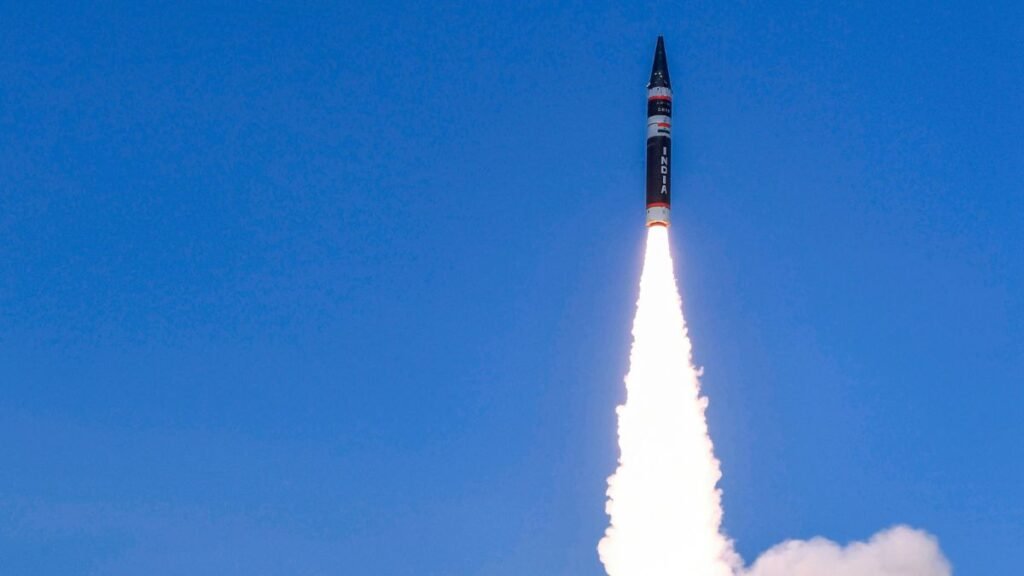|
Listen to article
Getting your Trinity Audio player ready...
|

In what is seen as a big breakthrough in India’s missile technology the DRDO successfully test-fired an Agni-5 missile with multiple independently targetable re-entry vehicle (MIRV) technology as part of Mission Divyastra from Dr. APJ Abdul Kalam Island in Odisha on 11 March 2024.
The primary objective of Mission Divyastra was to showcase India’s ability in Multiple Independently Targetable Re-entry Vehicle (MIRV) technology which amplifies the destructive potential of a single ballistic missile.
MIRV technology involves delivering multiple warheads to hit different targets with a single missile. A MIRV-equipped missile carries multiple warheads within a single body. During the final stages of flight, these warheads separate and re-enter the atmosphere on independent trajectories, allowing them to strike multiple targets.
Several countries, including the US, UK, Russia, China, France, and now India, possess the MIRV technology. The United States, Great Britain, France, China, and Russia are among the countries that deploy MIRV missiles, while Pakistan tested the technology in 2017.
The US is credited with developing and deploying the Minuteman III, the first operational MIRV system in the late 1960s. This was a turning point. The Minuteman III wasn’t the only US ICBM to receive MIRV technology. Over time, other missiles like the LGM-118 Peacekeeper were also equipped with MIRVs, further bolstering the US nuclear arsenal. By equipping missiles with multiple warheads, the US aimed to strengthen deterrence against a potential Soviet attack. The increased destructive power of a single missile made any aggression a riskier proposition.
The UK’s nuclear deterrent relies on the Trident missile system, carried by four Vanguard-class submarines. These submarines are constantly on patrol, maintaining a continuous at-sea nuclear capability. The Trident II D-5 missiles used by the UK can carry and deploy multiple warheads.
Russia, inheriting the Soviet Union’s nuclear arsenal, possesses a vast and advanced MIRV system. The Soviet Union was a key player in the MIRV race and actively developed and deployed MIRV technology on their intercontinental ballistic missiles (ICBMs) during the Cold War to counter the US advantage. With the end of the Cold War, the strategic landscape changed. The US and Russia (successor to the Soviet Union) engaged in arms control treaties like START (Strategic Arms Reduction Treaty) that aimed to reduce MIRV deployments. Russia’s current MIRV arsenal includes missiles like the RS-20 (SS-19 Stiletto) – one of the first Soviet ICBMs equipped with MIRVs, capable of carrying up to six warheads and the RS-28 Sarmat (SS-X-32) a new generation ICBM capable of carrying 16 MIRVs or a combination of warheads and hypersonic glide vehicles. Russia is actively modernizing its MIRV arsenal. This includes developing new ICBMs with even greater payload capacity for MIRVs.
France’s approach to MIRV technology is rather unique compared to other major nuclear powers. France began developing nuclear weapons in the 1950s and has maintained a continuous nuclear upgrade program since then. France did possess land-based ballistic missiles equipped with MIRVs in the past. These were deployed on silos at Plateau d’Albion. Over time, France’s nuclear doctrine evolved and it de-emphasized land-based ballistic missiles as it began to rely primarily on submarine-launched ballistic missiles (SLBMs) for nuclear deterrence. Accordingly, France eliminated its land-based ballistic missiles, including those equipped with MIRVs, in the late 1990s. This decision was based on the belief that the submarine-launched nuclear force was sufficient for deterrence. Presently, France does not deploy MIRVs on its land-based missiles. However, France’s current generation of ballistic missile submarines (SSBNs) – the Triomphant-class – uses the M51 SLBM. The M51 missile is believed to be MIRV-capable, meaning it has the physical capacity to carry and deploy multiple warheads. Estimates suggest it can carry anywhere from five to six warheads.
France plans to replace its Triomphant-class submarines with the next-generation SNLE-3G ballistic missile submarines. Whether these new submarines will be equipped with MIRV technology remains to be seen and will likely depend on the evolving strategic landscape.
China’s MIRV development is a topic of increasing concern. While there is no public confirmation yet, many countries, including the US, suspect China of possessing operational MIRV technology. Western intelligence reports suggest that China successfully test-launched a DF-41 missile fitted with MIRVs in 2016. This was a significant development in China’s nuclear capabilities. China’s potential deployment of advanced MIRVs is an issue closely monitored by the international community.
Increased MIRV capabilities in China could destabilise the balance of power in Asia, particularly in China’s equation with the US and India. The lack of transparency surrounding China’s MIRV program raises concerns about nuclear proliferation and the potential for an arms race in the region.
Israel is known to possess nuclear weapons but maintains a policy of “nuclear ambiguity,” meaning that it neither confirms nor denies having them. There is no confirmed evidence that Israel possesses or is developing MIRV technology for its delivery systems.
In 2013, there were reports that Israel might have transferred missile and electro-optics technology to China. This raised concerns from the US as it potentially violated export control regulations. However, there’s no evidence to suggest that the transfer directly involved MIRV technology. The lack of transparency surrounding the nuclear programs of Israel and China and their alleged military cooperation raises concerns about proliferation risks.
North Korea’s suspected MIRV capability is also a subject of speculation and close monitoring by the international community. Even though North Korea has not officially confirmed developing or deploying them, several factors suggest North Korea is pursuing MIRVs.






Add comment